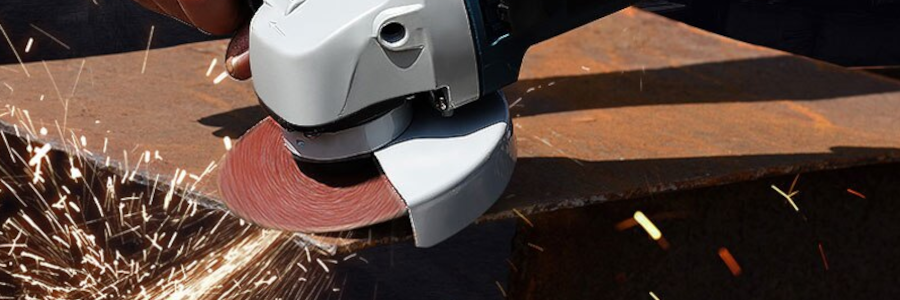Rust removal is tough. Fortunately, angle grinders make quick work of restoring rusty surfaces to like-new condition. Any angle grinder will generally work (here are our recommendations for the highest-rated corded and cordless angle grinders). The most important factor is the specific wheel or disc you choose for removing rust with an angle grinder.
There are three primary types of angle grinder attachments that are made for removing surface material that work well for rust removal:
- Strip discs
- Flap discs
- Wire wheels
It’s worth reiterating that all of these wheels are consumables, which means they break down during use. At 10,000+ rpm, they usually break down in all directions at once so EYE AND FACE PROTECTION IS AN ABSOLUTE MUST when removing surface material like rust or paint.
Each has their pros and cons and we’ll detail those below. But first, the quick and dirty for our recommendation for the best way to remove rust with an angle grinder.
The Quick Answer
We recommend WIRE WHEELS for their balance between aggressiveness and flexibility. They can tackle surface issues as well as the tight spots and pits that are endemic with severe oxidation.
Strip Discs
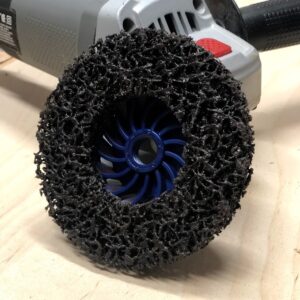 Strip discs are made from nylon strands glued together and coated with an abrasive. The most common abrasive is silicon carbide, which is known for its hardness. Weave patterns and specific abrasives may vary by manufacturer, but the base concept is the same: strip discs are really tough, gritty sponges that eat away at surface material like paint or rust.
Strip discs are made from nylon strands glued together and coated with an abrasive. The most common abrasive is silicon carbide, which is known for its hardness. Weave patterns and specific abrasives may vary by manufacturer, but the base concept is the same: strip discs are really tough, gritty sponges that eat away at surface material like paint or rust.
The abrasives used in strip discs are very hard. The most popular abrasive is silicon carbide, which among the hardest abrasives available to manufacturers. The hardness of minerals is measured along a grading scale called Mohs Hardness Scale from 1 to 10 (1 is talc and 10 is diamonds).
Silicon carbide is around 9.5 so it sits at the top of the scale in regards to mineral hardness. This is a good thing for rust removal because rust (or iron oxide) has a Mohs Hardness of 6.0, so we need something tougher than that for rust removal, such as the silicon carbide used in many strip discs.
A plus to strip discs is that they vary widely in aggressiveness. Since the amount of abrasive grit used on each disc can be accurately controlled, manufactuers can create different degrees of aggressiveness much like we’re used to seeing in sandpaper.
While the abrasives used in strip discs are very durable, the matrix that holds the material (the nylon webbing) is not. Like all angle grinder wheels, strip discs are consumables (i.e. they are made to wear away over time). The nylon sponge in strip discs that holds the abrasive wears away faster than other grinder wheel types.
Strip discs work well for removing all types of surface materials, but they wear down fast. They’ll eat away at rust but will also be eaten away themselves when used aggressively. We like them for paint removal since those jobs aren’t quite so heavy-handed.
Flap Discs
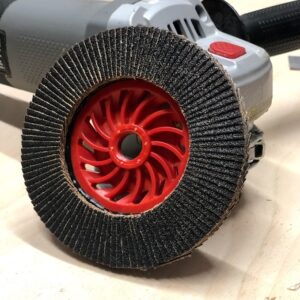 Flap discs are the next step up from strip discs. They are made from layers of overlapping sandpaper. Like strip discs, they come in a variety of grits or levels of aggressiveness depending on the grit size and concentration.
Flap discs are the next step up from strip discs. They are made from layers of overlapping sandpaper. Like strip discs, they come in a variety of grits or levels of aggressiveness depending on the grit size and concentration.
Many flap discs use a hard abrasive called aluminum oxide. These measure at about a 9.0 on Mohs Hardness Scale so they’ll be able to tackle any sort of rust you might encounter.
Flap discs are fairly durable. They last a bit longer than strip discs because the flaps can be made of thick paper or durable polyester to prolong the life of the disc as a whole.
This type of wheel is a bit more aggressive than strip discs. They can make quick work of rust removal but it’s also very easy to gouge soft materials like wood or aluminum. They’re backed by rigid fiberglass plates (instead of spongey mesh weaves) so there isn’t nearly as much “give” when removing rust.
It’s a two-sided coin: you need aggressiveness to power through rust ‘until’ you meet bare metal. It won’t take long to figure out how to finesse your grinder and flap disc to take off as much rust as needed without damaging the underlying metal.
Having a few different grits on hand will help with finish quality. Much like sandpaper and wood, starting with a higher grit and working down to finer grits (even incorporating a fine-grit strip disc) will increase the finished quality of your surface. Of course, this won’t matter as much if you’ll be coating the raw metal with paint or a protective finish but it will at least help with surface prep.
Wire Wheels
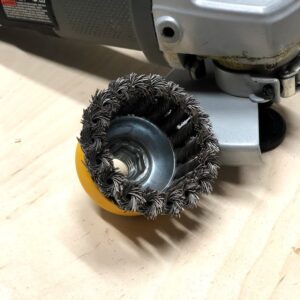 Wire wheels are a different beast than the other types of wheels. Unlike strip discs and flap dics, they don’t rely on a matrix impregnated with abrasives, but rather use strands of wire to eat away at whatever they meet.
Wire wheels are a different beast than the other types of wheels. Unlike strip discs and flap dics, they don’t rely on a matrix impregnated with abrasives, but rather use strands of wire to eat away at whatever they meet.
They come in different configurations depending on your preferred grinder orientation. Wire wheels hold the strands in a radial ‘sun’ pattern while cup brushes hold strands in a vertical direction. There isn’t really a performance difference between the two other than they allow you to hold your grinder in different ways.
Since there isn’t any abrasive grit to variate, manufactures rely on different gauge wires and strand construction to increase or decrease aggressiveness. Some of the more aggressive wire wheels incorporate twisted strands of wire, which prolong wheel life and allow for removal of tougher rust spots.
Wire wheels use steel as an abrading material, which is an important distinction. The wires built into wire wheels will have similar hardness factors as the material you’re trying to clean. The metal wires will be less likely to gouge your base material than tougher abrasive materials.
The metal strands that are tough yet flexible lend a happy middle ground between aggressiveness and control over the depth of abrasion. We liked that rust removal was relatively quick and our base material was preserved.
Our safety note at the top is most crucial for wire wheels. While the detritus from strip discs and flap discs are typically very small particles, wire wheels can throw whole wires (very bad for eyes).
Field Testing
We subjected each type of grinder attachment to our rusty subject: WWC editor’s offset smoker.
It’s a hand-me-down smoker that has seen its fair share of fantastic ribs and briskets (we feel obligated to pass on our favorite knowlege base, Amazing Ribs). It’s also seen its fair share of exposure to the elements in its 15 years of existence so it’s developed an impressive patina (i.e. lots of rust).
We’ll hit the backside of the smoker with each type of aforementioned disc/wheel.
Side-by-Side
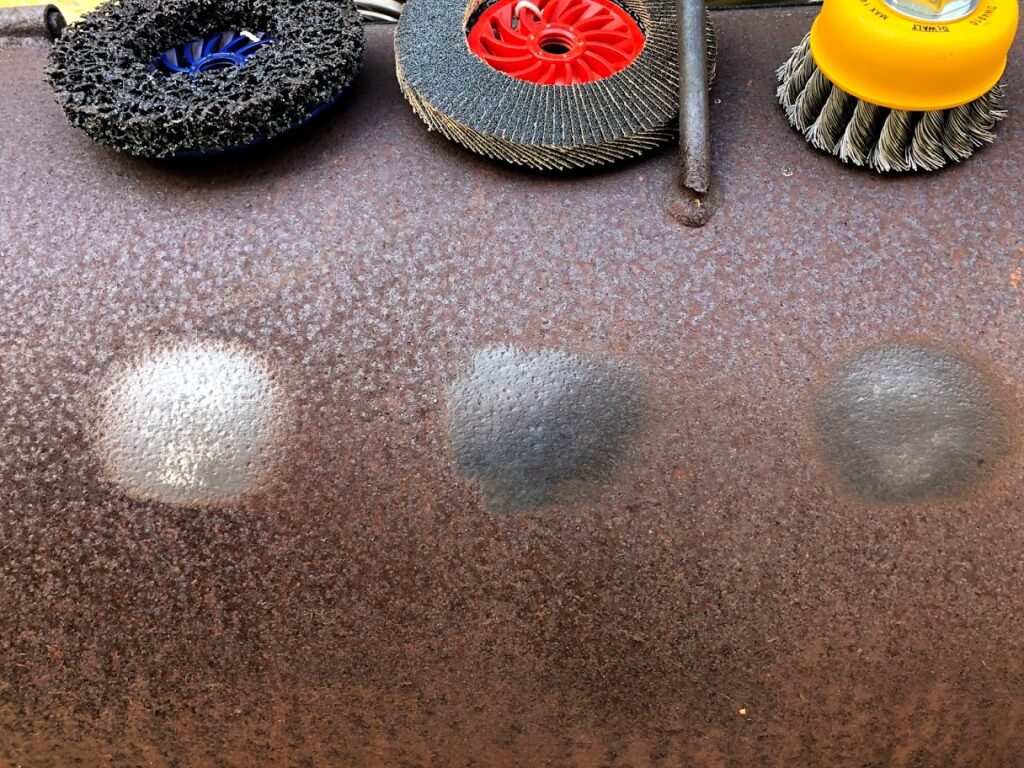
Here’s a side-by-side of the results. The sun hits the strip disc job (left) a bit more than the others so the bare metal looks a little lighter (but it’s just a glare).
Strip Disc
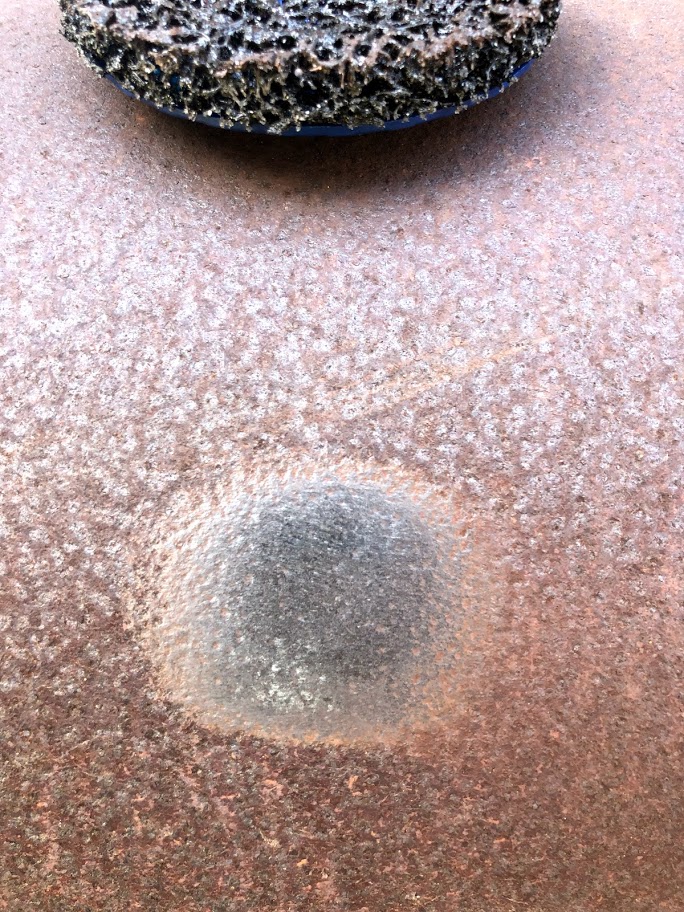
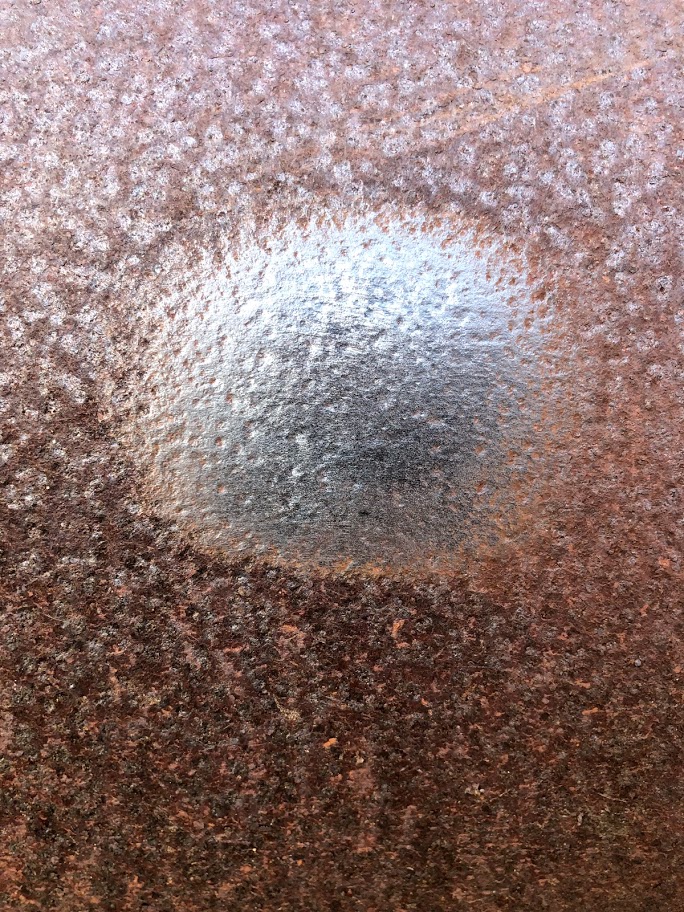
The strip disc performed well. Much of the surface rust as well as the pitting was cleared of the iron oxide but we chewed through the pad faster than the other discs. We noticed a bit of a sheen on the final surface; we suspect that the softer matrix burnished the surface after clearing the initial rust layer.
Flap Disc

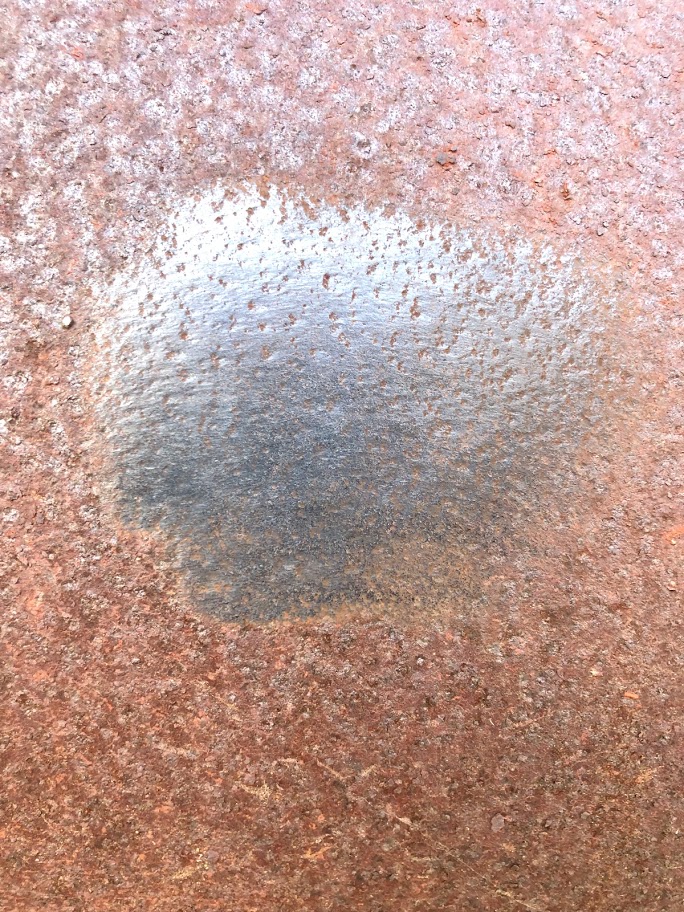
The flap disc was much quicker in removing the first layer of rust, but we noticed a considerable amount of residual rust in the pitting often found in this level of oxidation. The stiff backing on the flap disc proved to be a limiting factor in reaching the small nooks where rust likes to hide.
Wire Wheel
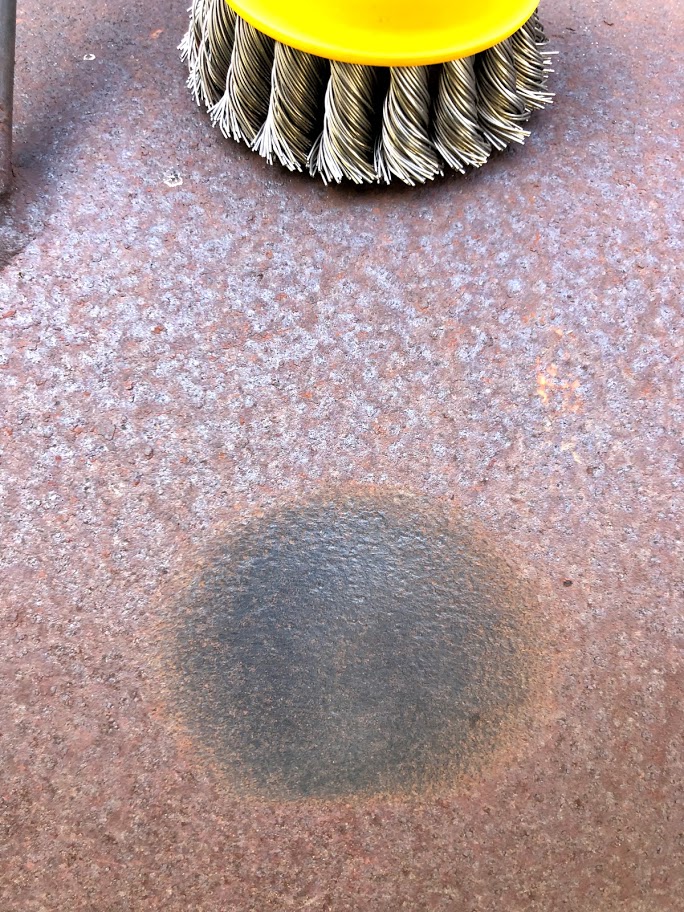

The wire wheel also performed well and quickly. It had no problem removing rust both on the surface level as well as in the pitting features induced by oxidation.
We liked that it seemed to stand up to continued use without any considerable deterioration. Also, the pitting was less pronounced after hitting the smoker with the wire wheel, so there’s likely a bit more aggression in the wire wheel’s performance versus the other options. It takes a bigger bite out of the raw material than the others, but not so much so that we were concerned.
Conclusions
WIRE WHEELS secure our top recommendation for the best way to remove rust with an angle grinder. Its twisted wire configurations are tough enough to grind through the rustiest of areas while remaining flexible enough to reach the hard-to-reach spots.
STRIP DISCS are a close second and performed well in our test. The only downside is the quicker degradation of the abrasion matrix. Since these tools use nylon as the webbing material, you’ll need to have a few of these on hand to make it through larger jobs.
If you choose to go this route, consider stocking up on a variety of grits and discs to ensure your workflow is uninterrupted.
FLAP DISCS removed surface rust very quickly, but the rigid backing material prevented the abrasive elements from reaching the pits that are commonly seen in heavily-rusted metals. We’d recommend this for removing rust from surfaces that aren’t suffering from any severe corrosion like pitting.

